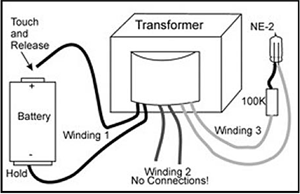This month I thought I’d give you amptechs a tip that is not widely known at all: it is not only possible, but easy, to test a transformer for internal shorts that are not otherwise detectable. Before you go and replace an expensive transformer, you need to try this.
Any of us who have worked on transformers are familiar with how you test for opens on the windings and shorts from winding to winding. You get out your ohm-meter and start measuring resistance. Opens where there is supposed to be resistance or resistance where there is supposed to be an open are dead giveaways. But what if there is one turn shorted down deep in the middle of a winding? The resistance testing will never pick that up – it’s not a big enough change in resistance.
Here’s how to tell if there’s an internal short. First, as always, unplug the amp for safety. If we disconnect all the windings of a transformer and then apply a DC voltage to only one winding, the iron core thinks it’s just an inductor. The voltage causes a current to flow in the inductor.
When you open the circuit, the magnetic field stored in the iron core creates a voltage on the winding to try to keep the current flowing – well-known inductor kickback.
All of the windings on the transformer are also magnetically coupled to the iron, and a proportional voltage appears on every one of them. If we connect a common neon lamp like the venerable NE-2 bulb to any winding and load up any winding with DC, when we open the DC loop, the voltage on all windings will increase until something conducts current. If all of the windings are open (as they should be), the NE-2 lamp will break over and flash when the voltage across it hits 75-90V.
But if there is a shorted turn inside the transformer, the iron’s stored magnetism will be entirely spent on trying to make the current keep flowing in that turn of wire. The neon light will not flash. 
First, make sure there are no loads on any winding. Then clip the neon and resistor across any winding. Touch your DC source to any winding, and then open it. Watch the lamp. If it flashes, there is no internal or external short. If it does not flash, there is a short. It’s that easy.
Keep in mind there are a few sneaky things that can invalidate your test. If there is a load on any winding, those loads will eat the inductive kickback and the neon will not light up. You’ll think you have a bad transformer but you might not. If the transformer is a power transformer, watch out for connections to filament windings or solidstate rectifiers. If it’s an output transformer, make sure the speaker is not connected and there is no minimum load resistor on the output jack or diode from plate to ground, as is found in some amps.
I don’t know who first thought this up, but I mentally thank them each time I have to test a transformer. Go ahead – try it!
R.G. Keen
Chief Engineer
Visual Sound
www.visualsound.net












![Rig Rundown: Russian Circles’ Mike Sullivan [2025]](https://www.premierguitar.com/media-library/youtube.jpg?id=62303631&width=1245&height=700&quality=70&coordinates=0%2C0%2C0%2C0)








